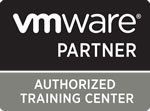VMWARE TRAINING COURSES

VMWARE TRAINING COURSES

Global Knowledge offers world-class VMware courses to ensure and validate the technical competencies and expertise needed to install, manage, deploy and support VMware software.
Why are our VMware courses great for you?
With a VMware certification recognized by the industry, you distinguish yourself from the crowd. It is proof of the knowledge you have gained and the way to demonstrate your VMware expertise. VMware certifications are available for 3 distinct skill levels on the current version of our software VMware vSphere and VMware vCenter Server.
Which VMware training courses do we offer?
We offer a total of 108 VMware courses, which can be distinguished into 15 categories according to their related technologies. They are available in a variety of formats, such as public classroom, virtual learning, company event, blended live, and on-demand (self-paced), depending on the course.
Explore our full range of VMware courses below including recently released vSphere 8. You can read out blog article to find out more about Dependent on this task
If you've completed VMware courses, get certified with VMware Certifications, and show off your new knowledge with a VMware Badge.
Interested in seeing our full range of VMware resources? Take a look at our documents, blog articles and whitepapers.

